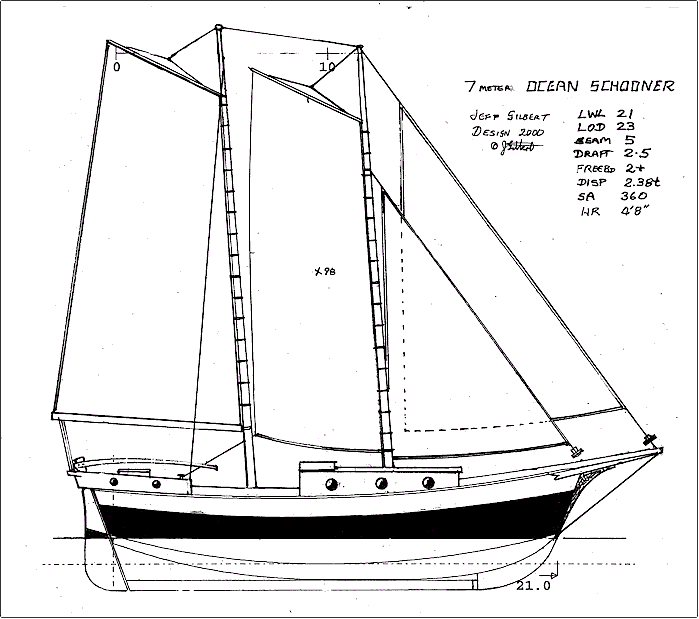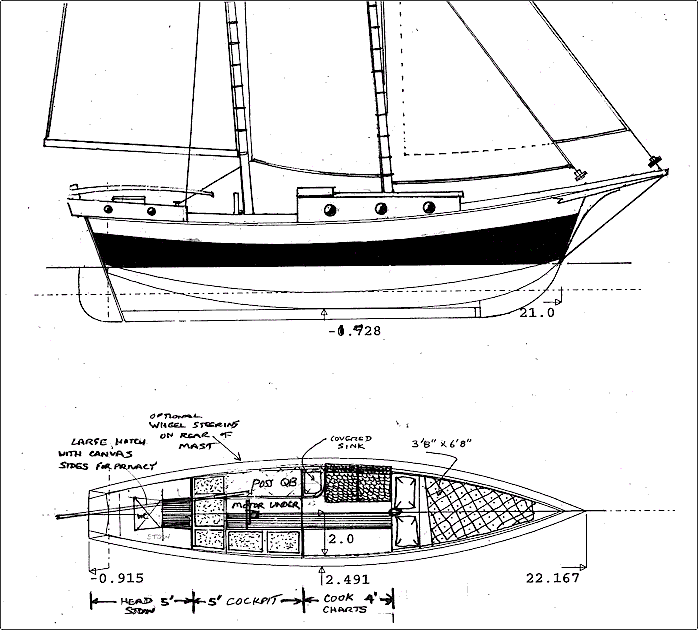|
Cartaphylla
Jeff Gilbert Design #117
Ocean Going Pocket Schooner
Imp. Specifications
| LOA |
27’ 8" |
Disp |
5300 lbs |
| LOD |
23’ 0" |
Ballast Ratio |
47% |
| LWL |
21’ 0" |
Aux (Elec?) I/B |
10 hp |
| Main Mast ASL |
24’ 0" |
Inch immersion |
367 lb |
| Mizzen |
23’ 0" |
Build time max |
2000 hrs |
| Bmax |
5’ 0" |
Batteries |
6 x 12v Gel |
| Draft |
2’ 6" |
C(Disp) |
(10.1, -0.5) |
| Deadrise |
20 deg |
CE lead over CLR |
NYA |
| HRmax |
(sitting) 4’ 8" |
SA/Disp (100%) |
19 |
| SA -Mains |
126, 98 |
Disp/WLL |
255 |
| -Jibs |
81, 55 |
Tankage |
50g + bags |
Notes on the Schooner Cartaphylla
Cartaphylla may be designed
by and for dreamers, but it proves a happy point. If you’re willing to forget popular
notions of how a boat should look, and design it for the task & tools at hand, you may
come up with a craft that’s unique, affordable and capable. And it might even look
good. Want to boldly go where everyone’s already been, only cheaper?? Read on….
The task at hand here is getting a couple across an ocean neither broke nor broken, and
hopefully undivorced. The tools at hand are a garage or shelter, and a few power hand
tools. A bench saw would be a big help, but one can get a Triton-type set up where you
bolt your power saw into a purpose made bench. If you have a thousand to start, and a job,
you can pay for this boat as you go.
The major compromise that makes this design work is the narrow beam, entirely
appropriate for schooners, but unusual in one of this size. The slim displacement hull
imparts speed & stability, & the ability to build it in even an English garage
(sorry Gav!)
Cartaphylla has a single hard chine, & is built from sheet ply/epoxy, glassed
outside. She is built upside down on a strongback in the standard manner documented
exhaustively elsewhere. Marine ply is 12mm, except the heavier bottom, 2 x 9mm which also
helps around the bow where the curvature gets a bit radical. Ply/lumber bulkheads and a
couple of ply ring frames are positioned on the strongback and fixed by chine logs,
stringers & most importantly the keel pieces.
This boat can be ballasted internally or externally. As the keel is the biggest hassle,
I’ve taken the law into my own hands here, and specified a 17ft length of lead filled
used six inch drill pipe. Get a bit that’s threaded one end if possible so you can
cap it. There are many ways to do the keel but I like this one: Make up the keel drawn in
the profile from 25 sq ft of 6mm steel plate welded to the top edge of your pipe, The
whole shooting match weighs in at 2500 lbs or 47pct ,and if you can keep this boat upside
down with that lot on you’re a pretty clever bloke. The shape of this keel is as
drawn but extending 150mm inside the wooden part of the boat, ie beyond the hull keel
line. The wooden part of the keel is two pieces of 25 x 150mm ply, gapped 6mm, full length
on edge. In the cabin the top edges of these take the floor sheet, which lifts anyway so
you can get at the bilge. These ply (or laminated) keel pieces are fixed to all bulkheads
with epoxy and glass tapes, and braced till the whole shebang is stiff and strong.
Features from stem to stern,,,,,
1/ The laminated ply bowsprit
4’ 6", could be designed to pivot back. Pulpit recommended but not drawn.
2/ Foredeck is turtled in centre but level from foot of cockpit coaming forrd. This
creates an extremely safe work area, at the expense of needing a deck drain and only 2
feet clearance over the forrd section of the bunk. Anchor rides under sprit, small well
forrd of bunk for warp.
3/ There is no forehatch (porthole vents) as the foredeck and forrd deckhouse fit
Sqeezebox, the sailing lifepod tender. She doesn’t impose badly parked upside down
with the two foredecks cheek to cheek.
4/ V-Berth has flotation, 50 gallon water tank and lockers under. The 500lbs of water
balances the lazzarette, the ships store!
5/ Two’s company, three’s a crowd applies in this little saloon, though it
does have a 24" sole & 4’8" headroom. The beam precludes a lot of
clambering over other bods-you can sit cook read eat navigate and sleep comfortably. If
you want to stand up you can do so in the companionway or cockpit. The utility bench is a
foot deep only, containing lockers, but with footspace under so you can stretch right out
in the settee/chairs opposite. The locker door is hinged to the top so you can swing it up
and extend the bench to 30 inches or half the boat wide. You can seat 3 for a meal using
the end of the bed. Theres a tight quarter berth which is more for extreme conditions use
- you’d be safe from falling and possibly even getting out. Removal of rear cushions
(these are thick to fill the void created under the 6" side deck) makes this berth a
lot wider at 21" than it appears in the drawing. The seat side-table folds to cover a
cabin bulkhead porthole, and a map taped to it can be read from the helm. Note that these
seats could be widened to two armchairs if a builder wished. This cabin is a cosy little
haven unless you try to fit too much in it. Its small but not cramped, and the expanse of
bed relieves its confinement visually.
6/ Saloon comfort comes partly at the expense of side-decks which a the width of a foot
(not a foot in width!)
7/ The cockpit is large but with a narrowish 18in self draining sole which cant scoop
up too large an amount of ocean. Its set fairly high but sheltered by coamings that extend
from the cabin to the poop, which acts as a backrest for tiller steering. Alternately a
wheel could be mounted on the mainmast base. Forrd of the mast is a good spot to corral
guests with the loose-footed mizzen unlikely to scragg even the most errant landlubber.
8/ The poop deck enlarges the lazarrette into a room which will hold spare sails and
stores with enough room for the dread bucket. You can take your ease with full privacy
& seated HR under a large hatch with canvas fold-in sides.
9/ Auxiliary is intended to be an electric with a bank of four gel batteries and 2
spares distributed about to trim the ship. The shaft would be horizontal (dotted line in
drawing) with the prop in the usual cutout between keel and rudder.
Unfortunately the costs of
commercial marine electrics are prohibitive, and a second hand Yanmar or similar would
seem the best solution. A small stern drive or outboard would also be possible. This is
definitely an area that’s flexible.
The author would also like to point out that theres a good spot to row from just forrd
of the mainmast!
10/ Masts are keel stepped spruce spars and sails can be home made (developed panel
designs available from the author). Second hand rigs and sails are a viable cost saving
alternative. Also an American company makes sturdy 20ft flagpoles which telescope to four
feet and would be brilliant for passing the low bridges in European canals. This boat
would be eminently suited to a combined sea and inland voyage, with her shoal yet
seaworthy design and narrow beam.
11/ Sails look well tan or maroon. The sails can all be single-handled without winches
from the cockpit area. Sails should be made strong with slab reefing, and the only spare
sail needed is mizzen that can be used as a spare main and boom tent in the tropics.
Cartaphylla can be sailed alone and really booted along by two. Theres is no need to
run a spinnaker as she goes belts downwind wing and wing, high bow in the air. The high
ballast ratio means shell stand up well to her sails…this boat will continue to turn
the miles in crook weather. Loading beyond the waterline at the start of a trip wont worry
her. Sails are divided into small manageable chunks and in time the sailor will find
theres a combination for all conditions, and that in certain conditions shell hold course
with just a string on the helm.
Don’t be fooled by Cartaphylla’s sleek lines and elegant spars into thinking
this boat is a show pony. Shes as strong as a Mallee Bull, will do her hull speed of 6
knots anytime, and will get you across the pond, no worries.
Copyright Jeff Gilbert
[email protected]
September 2000





|